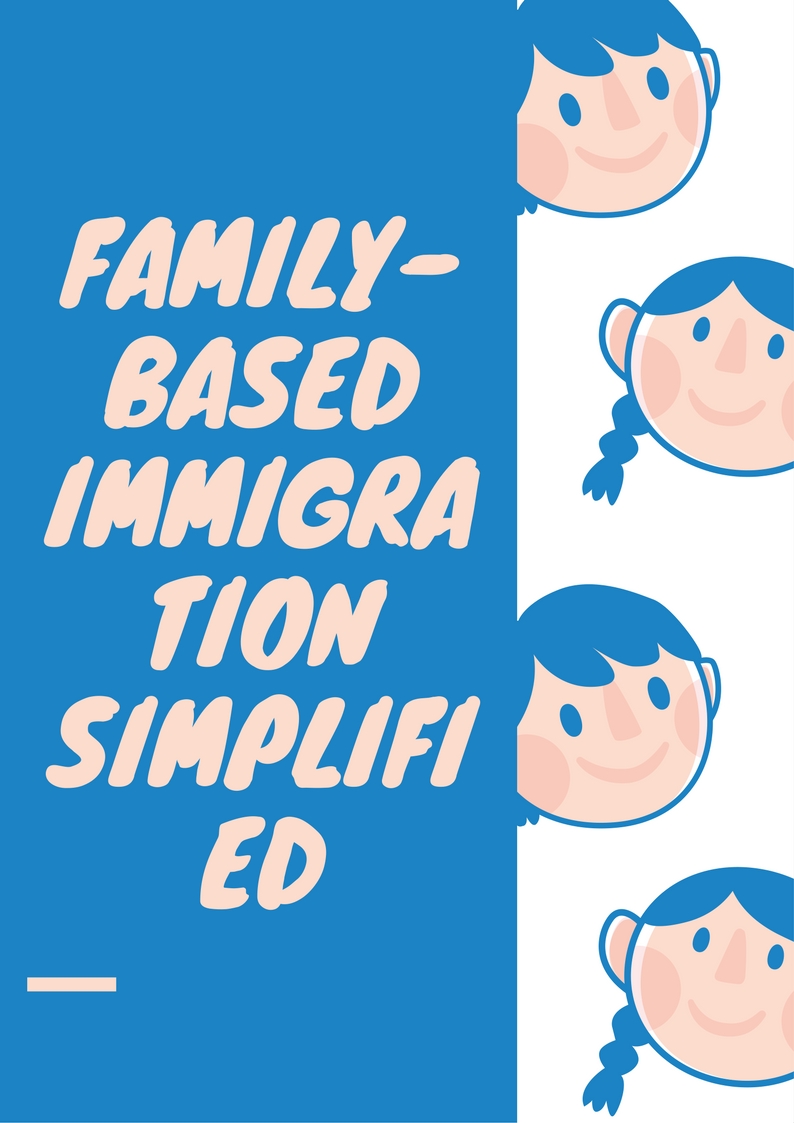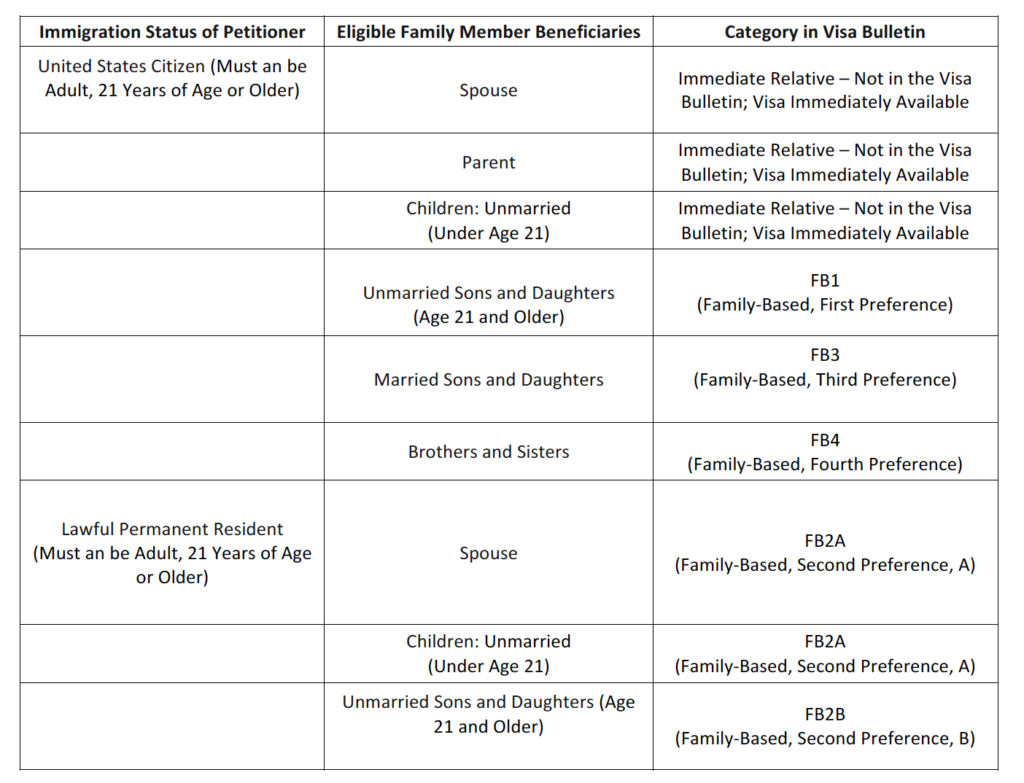Murthy Law Firm receives many questions about immigration petitioning for relatives. While there are various nuances to this topic, Murthy Law have simplified the initial, fundamental question: who may file for permanent immigration benefits to provide the “green card” for their relatives. These are available in an easy reference chart created for the benefit of the readers. If you need a legal help with filing a petition you can go to The Murthy Law website to get more information. Also remember to buy Health Insurance before coming to the U.S. Please read more about Visitor Health Insurance Plans and Health Insurance Plans for US citizens and residents.
 Who May Petition for Green Cards for Relatives?
Who May Petition for Green Cards for Relatives?
As can be seen in our chart below, petitioners must always be adults, 21 years of age or older. They may be either U.S. citizens (by birth or naturalization) or U.S. permanent residents (green card holders). The list of relatives for whom a permanent resident can file is not the same as the relatives for whom a U.S. citizen may file as sponsor or petitioner.
Which Relatives Can Benefit?
The second column of the chart identifies the relatives who may be beneficiaries in a family-based petition. Both U.S. citizens and green card holders may petition for their spouses, minor children, and unmarried sons and daughters (21 or older). However, as mentioned before, there are other differences between the relatives who may be beneficiaries of a case filed by a U.S. citizen, as opposed to those in a case filed by a green card holder. U.S. citizens may petition for their parents, married sons and daughters, as well as their siblings. (U.S. citizens can also file for fiancé/es, but because this is a temporary category, it is not included in the chart pertaining to permanent immigration benefits.)
How Long Will the Process Take?
The question of how long a particular case will take can be a bit complicated. The United States sets strict annual limits on the number of individuals who may immigrate permanently each year. This is determined by the case category and country of chargeability. The date that the petition for a relative (Form I-130) is filed establishes the priority date. This, essentially, sets the family member’s place in the queue. The waiting time in some categories is measured in years and, in some situations, is more than a decade. The situation for those cases categorized as immediate relatives, as explained below, is far more favorable.
The U.S. Department of State (DOS) controls the annual legal limits on permanent immigration to the United States by the use of visa numbers, available in accordance with the legal limits. The availability of visa numbers by category is reflected in the monthly DOS visa bulletin.
The third column in the chart contains the visa bulletin category for the various types of family-based petitions. The categories are known as preferences.
As noted, some relatives of U.S. citizens are categorized as immediate relatives. These cases are not subject to visa number backlog, and are not reflected in the visa bulletin. These cases can move forward without waiting times for visa numbers. The paperwork needs to be processed by the U.S. Citizenship and Immigration Services and, in some cases, the DOS, through a U.S. consulate abroad. The waiting time for this paperwork processing is usually far less than the waiting time for visa number availability in family-preference cases.
Derivative Family Members: What About the Kids?
The chart reflects the relatives for whom a petition may be filed. The relative being sponsored is known as the primary beneficiary. The next concern, in many instances, is the spouse and/or children of the primary beneficiary.
In the family-preference categories, the spouse and/or minor children of the primary beneficiary may also benefit from the single-petition filing. These family members are eligible for the same family-based category and priority date as the primary beneficiary. Their immigration benefits are dependent upon approval of the primary beneficiary’s case.
This benefit is limited to preference relatives, and does not extend to immediate relatives. Immediate relatives do not have derivative beneficiaries. Thus, their spouses and/or children must have petitions filed for them separately, and must independently qualify for those benefits. This is confusing for some and failing to file for dependents of the immediate relative can result in lengthy and unexpected delays. It is important to understand the charts. In many cases, it is advisable to consult with an immigration lawyer who can guide you if you are not sure how to proceed.
Example A
A U.S. citizen files an I-130 petition for his brother. The brother is married. Once the priority date becomes current, the brother and his wife (petitioner’s sister-in-law) and their unmarried children under 21 years of age can immigrate under the family-based, fourth preference (FB4) category. The entire family in the FB4 category all obtain the same priority date based on a single I-130 petition.
Example B
A U.S. citizen files an I-130 for his mother. The case falls within the immediate relative category. Thus, there are no derivative beneficiaries. If the U.S. citizen also wants his father to immigrate, a separate I-130 petition must be filed for the father.
Moreover, there are also no benefits given to other children of the parents in Example B, even if those children are under 21 years of age. The U.S. citizen would have to file yet another I-130 for each sibling who wished to immigrate. The case for the siblings, however, would fall under the FB4 category, and would have a long waiting time (quite possibly 13 years or longer). The case for the parents has no visa number waiting time; it has only the standard paperwork processing times.
One Cannot Sponsor In-Laws, Aunts, or Uncles
The rules for derivative beneficiaries often cause confusion as to which relatives can file for whom. One may believe that s/he immigrated based on a petition filed by an aunt or uncle, or by an in-law.
In truth, such a person immigrated as a derivative beneficiary, with a petition that was filed for his/her own spouse or parent. The aunt or uncle would have filed an FB4 petition for a sibling, and the nieces and nephews would immigrate as derivative beneficiaries of their own parent (the primary beneficiary).
The same concept holds true of petitions filed by an in-law. The filing is made for the direct relative (child or sibling), as a primary beneficiary, the spouse (the petitioner’s daughter/son-in-law or brother/sister-in-law ) immigrating as a derivative beneficiary.
Conclusion
While there are many details and nuances within family-based immigration, the starting point is to know which relatives one is allowed to legally sponsor under U.S. immigration law. With the referenced family chart, it is easy to obtain this information, and to ascertain how to track waiting times based on the DOS visa bulletin. Those with questions regarding family-based options may wish to schedule a consultation with a Murthy Law Firm attorney.

You can go to the Murthy Law website to learn more.
During the immigration process don’t forget to purchase Visitor Health Insurance with good medical insurance coverage. Please read more about Health Insurance Plans for immigrants offering by India Network Services.
About India Network Health Insurance:
India Network Services is a US-based company that administers visitor health insurance to tourists, students, temporary workers and their families. Visitor medical plans are offered for all age groups with both fixed coverage, comprehensive coverage and with or without pre-existing condition coverage.
